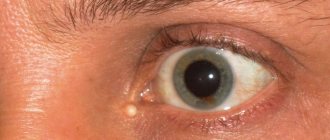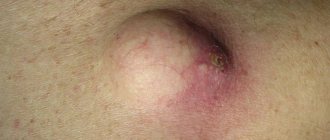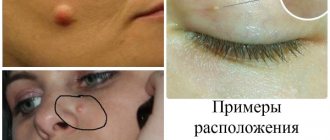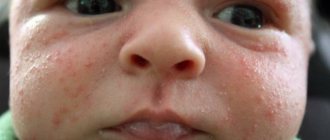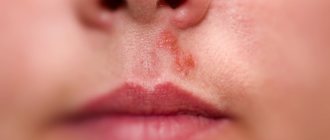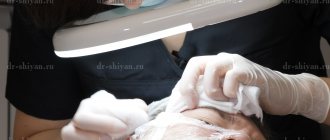What is a wen?
Wen (lipoma or milium) is a benign formation that does not pose any threat to human health. This is just an unpleasant cosmetic flaw. Wen differs from other formations in its mobility and softness.
Last time we discussed another benign neoplasm - fibroma. Read more about fibroid removal here.
They do not cause any discomfort or pain, as they represent overgrown adipose tissue. Wen can appear in any part of the body. As a rule, on the face they are observed mainly in the upper part.
Very often, wen appears on the face of newborn children. This problem bothers adults, causing many problems. Parents should know that this phenomenon is not considered a pathology and does not pose a danger to the baby’s health.
Externally, wen resemble small closed white pimples. They appear in groups of several formations on the forehead, near the eyes, as well as on the nose and chin. Typically, wen disappears on its own a few weeks after the baby is born.
Preventive actions
Experts recommend following the tips described below from birth to prevent the development of tumors in a child:
- physical activity appropriate for the child’s age (gymnastics, massage);
- a diet with plenty of fresh vegetables and fruits for the mother if the baby is breastfed;
- timely implementation of hygiene procedures.
It is strictly prohibited to get rid of benign tumors in a child without consultation. Careless manipulation can cost the newborn's health.
Causes of wen on the face of a newborn
Most parents perceive wen on the face of a newborn baby as a fairly serious danger to his life. Therefore, they begin to actively fight them, not realizing that they are only aggravating the situation and preventing the child’s skin from cleansing.
The appearance of wen on the face of newborns has not yet been fully studied, so identifying the true cause of this phenomenon can be very difficult.
Today we have only a few assumptions:
- The main cause of wen in young children is associated with immaturity of the skin tissue, which causes blockage of the sebaceous glands. Such formations do not require any treatment and disappear on their own after a month from the date of birth of the child.
- Active release of hormones in a pregnant woman immediately before childbirth.
- Artificial feeding.
- Improper metabolism.
- Genetic predisposition (if one of the parents has similar rashes).
- Improper skin care for a newborn, use of linen and clothing made from non-natural materials.
Lipoma in a baby
The term lipoma is used by doctors to refer to benign subcutaneous tumors that are composed of fat cells. They can occur in patients of different ages, including infants. Most often, such tumors are localized on:
- Back.
- Hips.
- Shoulders.
- Neck.
- Shins.
Lipomas are characterized by fairly specific symptoms. As a rule, such neoplasms:
- Feel with your fingers.
- They are mobile and elastic.
- They do not cause discomfort or pain.
- They have a diameter of about 1.5-2 cm. With active growth, the lipoma can grow larger - up to 10 cm.
In newborns, tumors may well be congenital. In such a situation, they are often penetrated by small vessels and grow into the muscles, which significantly complicates their treatment.
Causes of occurrence on the body and head
Scientists suggest that the main reason for the development of lipomas in newborns lies in a systemic disturbance of metabolic processes in adipose tissue. It is assumed that the emergence of such neoplasms can also be contributed to by:
- Genetic predisposition.
- Liver pathologies.
- Pancreatic diseases.
- Disorders of the thyroid gland.
Most often, doctors are unable to determine the exact causes of lipomas in a baby. Treatment in such a situation is aimed only at getting rid of the defect.
What to do?
As a rule, lipomas in newborns are removed surgically. Only sometimes, when the tumors are small in size and have a specific location (where the tumors cannot be injured, put pressure on surrounding tissues, etc.), the doctor can only recommend observing the wen. In this case, removal is carried out only if complications develop - with active growth of the lipoma or its inflammation.
When eliminating wen in children, doctors usually resort to a full-fledged surgical operation using a scalpel under general anesthesia. This allows doctors to completely remove the tumor along with the capsule, and it will subsequently no longer be able to recur. In addition to the classic operation, the following can also be performed:
- Laser removal.
- Radio wave removal.
These are less invasive interventions, which significantly reduce the risk of complications and also shorten the recovery period. But not every clinic will risk using a laser or radio knife to treat infants.
Types of wen on the face
There are diseases that pose a danger to the health of children, which in appearance are very similar to wen:
- Milia are small white formations that protrude above the skin. Another name for them is whiteheads that do not have a duct. Milia are filled with sebum and can appear on any part of the facial skin, either singly or in groups. Typical locations are cheekbones, forehead, nasolabial folds and wings of the nose. These formations are held quite firmly on the skin, so they are practically motionless. In case of multiple milia rash, the skin looks bumpy and uneven.
- Xanthelasmas . Their main difference from milia is their larger sizes and shades. As a rule, they have yellow tints. In addition, xanthelasmas have the ability to actively grow, increase in size and connect with each other. This type of wen is a mobile formation and requires fixation during removal. Location: upper and lower eyelids.
Usually, wen on the face does not have any clinical picture. If you press on it, there is a sensation under the skin of a foreign round movable formation.
Symptoms of a wen on a child’s face
In most cases, wen on the face develops without any symptoms. A characteristic feature of wen is that it appears on areas of the body with minimal fat. On the face they appear in the form of a protruding tubercle.
Lipomas on the face of newborn children are a completely natural phenomenon. They are rashes of small diameter. Their location is the forehead, nose and chin.
Xanthelasmas can be seen through thin skin in the form of yellow plaques of various shapes and sizes with blurred contours. Over time, their diameter may increase, but usually this happens for a very long time.
Xanthelasmas have a soft consistency and begin to move upon palpation. Unlike a subcutaneous pimple, it is impossible to squeeze out a wen. Due to the close location of the wen to the nerve endings, pain may occur when pressed.
Wen are often confused with other types of formations (atheroma or cyst) that require surgical intervention due to rapid growth.
You might be interested! Lipoma on the human body: what is it and why is it dangerous?
Forecast
In most cases, a lipoma only brings cosmetic discomfort to the child. Moreover, many wen resolve on their own after some time. However, the formation of defects in the ears and near the eyes is fraught with hearing loss or deterioration of vision, so such neoplasms should be urgently examined by a specialist.
With the development of the inflammatory process or suppuration, the rapid growth of the tumor, the prognosis sharply worsens. A large formation compresses blood vessels, impairing blood circulation, and nerve endings, causing severe pain.
Inflammation and accumulation of purulent masses are dangerous due to sepsis, which can even lead to death. Therefore, even a small lipoma should be strictly monitored by a doctor to avoid serious problems.
Diagnostics
Apart from external manifestations, there are no other symptoms of the appearance of wen in children. They are diagnosed by a surgeon or dermatologist through external examination of the skin and palpation. The doctor will also find out from the parents all the necessary information: the time of appearance and the intensity of growth of the wen. After receiving the data, the doctor makes a diagnosis.
If a serious disease (malignant neoplasm) is suspected, the doctor may prescribe a histological examination. Sometimes, in order to avoid the spread of wen to other parts of the newborn’s body, additional procedures (MRI, computed tomography) are performed.
How to get rid of wen?
We have already covered in detail how to get rid of wen on the face, here we will talk about the features of getting rid of them for children.
Many parents, having noticed wen on their baby’s face, think that they can simply be squeezed out. This cannot be done, if only because, in this way, an infection can be introduced into the child’s body. As a result, a serious inflammatory process may begin, which will be very difficult to cure. There are other methods of getting rid of wen in newborns.
Treatment methods:
- Conservative treatment. This method involves the use of special medications that are administered inside the formation. Thanks to their absorbable action, they help to get rid of the wen easily and quickly. The only drawback of the conservative method is that one session will not help solve this problem. It is necessary to carry out a full course of treatment, which is very difficult for a newborn baby.
- Surgical method. There are cases when a wen can be dangerous to the child's health and must be removed through surgery. This method involves the use of local or general anesthesia, depending on the volume of formations and the individual characteristics of the child’s body. During the operation, the doctor makes an incision and squeezes out the contents of the wen. After this, he cleans the lipoma capsule itself.
- Laser method. This is the most effective and gentle method, since the laser beam has a positive effect on the regeneration process. It has coagulating and antibacterial characteristics, thanks to which wen removal is achieved without blood loss, scarring and side effects. The laser method is most suitable for eliminating formations on the face, since after a week not a trace remains of the wounds. After such an operation, the specimen is sent for a special histological examination.
- Puncture-aspiration method. This procedure is reminiscent of cosmetic surgery using a needle. The surgeon injects it into the tumor and sucks out the contents of the wen, preserving the membrane. The disadvantage of the puncture-aspiration method is the possibility of reappearance of the wen.
Likely consequences
Almost always, lipomas do not threaten the health of infants. Only in isolated cases do tumors degenerate into malignant neoplasms. The most common complication of a wen is the development of an inflammatory process.
Can a lipoma resolve on its own?
Lipoma (fat) is a benign neoplasm.
This phenomenon causes pain, redness, and increased temperature of the affected area. If you do not contact a specialist in time, a purulent process develops, threatening blood poisoning.
When you try to squeeze out a lump yourself, an infection often occurs. Considering that newborns have an extremely weak immune system, such a complication should be immediately eliminated by an experienced doctor.
Prevention
There are no special recommendations for the prevention of wen in children, since their occurrence has not yet been fully studied.
It is only known that in order to avoid their occurrence it is necessary:
- carefully choose baby care products;
- make changes to the baby’s diet: eliminate sweets and fatty foods, add more vitamins and healthy quality foods;
- Maintain child hygiene and monitor the condition of facial skin;
- An equally important condition is the timely passage of medical examinations, as well as treatment and removal of formations in order to eliminate consequences dangerous to the child’s health;
- never self-medicate.
If wen does not need to be treated, it is good to wipe the child’s face with decoctions of string and chamomile. It is also necessary to carefully ensure that the baby does not scratch his own face and cause an infection. Therefore, cut his nails more often and wear special gloves.
If an infection occurs, contact your pediatrician, who will prescribe you the most effective antibacterial agent.
Clinical manifestations
As in adults, lipomas in newborns are mobile. The disease looks like a painless, soft but elastic lump. Moreover, the color of the skin does not change. In the absence of complications, the wen does not worsen the child’s well-being.
If the gums are affected, the neoplasm resembles a small ball. In addition to lipoma, benign atheromas appear.
Such defects are immobile and often reach large sizes. Moreover, atheromas often become infected and fester, which is extremely dangerous for the health and life of the baby.
